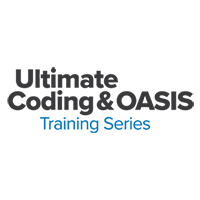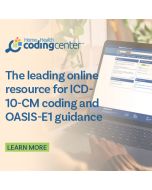This site uses cookies in order to give you the best experience.
We and our third-party partners may use cookies and similar technologies,
for example, to analyze usage and optimize our sites and services, personalize content,
tailor and measure our marketing and to keep the site secure.
Please visit our privacy policy for more information.
Privacy Policy
OASIS Training & ICD-10 Intermediate Coding
$749.00
Product Code:
XUTSVJ
Learn how to properly answer the new OASIS items AND how to sequence the most common home health diagnoses in ICD-10 through this seminar package.
Receive on-demand OASIS training and valuable CEUs!
Interested in Registering Multiple Attendees?
Send your team of three or more and save an additional 10%! Your savings will automatically calculate in your cart when you register.
Prefer to register by phone? Contact John Prentice or Megan Ireland at
1-855-225-5341 x4005 or email us at HCEvents@hcpro.com
Interested in Registering Multiple Attendees?
Send your team of three or more and save an additional 10%! Your savings will automatically calculate in your cart when you register.
Prefer to register by phone? Contact John Prentice or Megan Ireland at
1-855-225-5341 x4005 or email us at HCEvents@hcpro.com
Ultimate Coding & OASIS Training Virtual Series:
OASIS Training & ICD-10 Intermediate Coding
Presented on: On-Demand
Presented by: Arlynn Hansell, PT, HCS-D, HCS-H, HCS-O, COS-C, Director of Education, Coding and OASIS Division, for SimiTree Healthcare Consulting
Make the most out of Ultimate Coding and OASIS Training: The Virtual Series by combining two programs!
This seminar package gives you both popular courses from the Ultimate Training Series: OASIS & ICD-10 Intermediate Coding!
OASIS Training:
Learn how to properly answer the most challenging OASIS items while reinforcing your core OASIS competencies without sacrificing productivity.
OASIS accuracy is the key to documentation compliance, positive outcomes scores and full and proper reimbursement. Attend this full-day, intermediate-level OASIS training on the most challenging items – those questions that continue to create confusion and put your agency at risk when answered incorrectly. Expert speaker Arlynn Hansell includes opportunities to pause the recording to work through OASIS scenarios, which she discusses in depth to ensure retention and comprehension.
During the training, you will:
- Dive into the most challenging OASIS items and guidance, including Section GG, J1800, and J1900.
- Avoid CMS surveyor scrutiny with best practices for answering the OASIS SOC/ROC in timely fashion.
- Correctly apply OASIS conventions to item-specific scenarios while also learning how to apply OASIS-specific definitions for terms such as active treatment, care episode, same day, minimal assistance, and more.
- Master the complicated wound items, including how to report pressure ulcers, stasis ulcers, surgical wounds and trauma wounds, and how to report their healing status.
- Ensure accuracy in the reporting of cognitive patterns, including the neuro/emotional/behavioral items to ensure appropriate POC development and risk adjustment of outcomes.
- Work through the ADL items (M1800 - M1860) to ensure you're accurately reporting the patient's functional status, or risk PDGM Functional Impairment Level Points and inaccurate outcome scores.
- Walk away with best practices to ensure your documentation matches the OASIS, which matches the plan of care.
- Understand the interaction of certain OASIS and coding items and how they impact the PDGM payment system
ICD-10 Intermediate Coding:
Learn how to sequence the most common home health diagnoses in ICD-10 and understand the FY2022 code and guideline changes. Expert speaker Arlynn Hansell includes opportunities to pause the recording to work through scenarios, which she discusses in depth to ensure retention and comprehension.
More specifically, this training will cover:
- Coding conventions and guidelines: Delve into the assumptions that can and cannot be made in ICD-10.
- COVID-19, including how to code active manifestations of COVID-19 vs late effects, including post COVID long-haulers condition; and when to assign Z86.16 instead of U07.1.
- Documentation, OASIS, and coding: Learn how they work together to affect payment in the PDGM system and create a compliant record.
- Fractures, including traumatic and pathological fractures.
- Z codes versus a complication code: Work through scenarios to learn how to properly assign these codes.
- Wounds, including pressure ulcers, infected and non-healing surgical wounds, stasis ulcers and trauma wounds.
- Diabetes: Learn how to choose the right code from five code categories, and review the differences in coding diabetic manifestations.
- Cardiopulmonary, including hypertension, heart failure, and COPD versus asthma with COPD exacerbation versus emphysema.
- CVA & late effects: Learn how to apply the 7th character to indicate sequela, as well as how to code dominant vs. non-dominant.
- Symptom codes, including how and when to use them in PDGM.
- Mental health codes, including how to accurately code anxiety and depression, and substance abuse.
- Nervous system coding, including assigning the correct codes for post-polio syndrome, Alzheimer’s disease, Parkinson’s, MS, pain and seizures.
- Neoplasms & anemia, including surgical aftercare for neoplasms, and the key changes in coding anemia associated with malignancy, and anemia resulting from chemotherapy, immunotherapy and radiation therapy.
- GI/GU, including how to report kidney disease (CKD), colitis and obstructions.
- Poisoning and adverse effects: Learn how to report these diagnoses in ICD-10 when you will no longer be required to use the external cause codes (V00-Y99) – comparable to the E codes in the current set.
- Review the differences between sepsis, SIRS, and septic shock, and identify correct infection verbiage for accurate coding.
Required material: All participants must have a 2022 ICD-10-CM coding manual OR the Home Health Coding Center to participate. We recommend DecisionHealth’s 2022 Complete Home Health ICD-10-CM Diagnosis Coding Manual or DecisionHealth’s Home Health Coding Center
At the conclusion of this virtual training, the participant will:
-
Learn the specific OASIS-D1 items and updated guidance effective January 2021
- Avoid CMS surveyor scrutiny with best practices for answering the OASIS SOC/ROC in a timely fashion
- Correctly apply OASIS conventions to item-specific scenarios, while also learning how to apply OASIS-specific definitions for terms such as active treatment, care episode, same day, minimal assistance, and more
- Master the complicated wound items, including how to report pressure ulcers, stasis ulcers, surgical wounds, and trauma wounds
- Ensure accuracy in the reporting of neuro/emotional/behavioral items
- Work through ADL items to ensure you're accurately reporting the patient's functional status
- Walk away with best practices to ensure your documentation matches the OASIS, which matches the plan of care
- Understand the interaction of certain OASIS items and the new Patient-Driven Grouping Model (PDGM) payment system
- Focus on the assumptions within the coding conventions and guidelines
- Describe how documentation, OASIS, and coding all work together to affect payment in the PDGM payment system and create a compliant record
- Discuss scenarios for assigning Z codes versus a complication code
- State the difference between sepsis, SIRS, and septic shock, and identify correct infection verbiage for accurate coding
- Identify when surgical aftercare is needed for neoplasms versus the diagnosis itself
- Demonstrate how to choose the right code when dealing with all the possible manifestations of diabetes
- Identify the complexities of combination coding of hypertension, heart failure, CKD, and COPD versus emphysema
- Learn to choose the right code to identify sequelae of a CVA
- Identify the difference between poisoning and adverse effects, and how to code these diagnoses in ICD-10
Agenda
All registrants receive access to the online learning, downloadable slides, and relevant accompanying materials.
In the OASIS seminar you will:
- Hammer home the most challenging OASIS items and guidance, including Section GG, J1800 and J1900 (falls).
- Avoid CMS surveyor scrutiny with best practices for answering the OASIS SOC/ROC in a timely fashion. Learn how to answer M0102 (date of physician ordered SOC) and M0104 (date of referral) in challenging situations.
- Correctly apply OASIS conventions to item-specific scenarios while also learning how to apply OASIS-specific definitions for terms such as active treatment, care episode, same day, minimal assistance, and more.
- Master the complicated wound items, including how to report pressure ulcers, stasis ulcers, surgical wounds, and trauma wounds, and how to report their healing status.
- Ensure accuracy in the reporting of neuro/emotional/behavioral items (M1700–M1745) to ensure appropriate POC development and risk adjustment of outcomes.
- Work through the ADL items (M1800–M1860) to ensure you're accurately reporting the patient's functional status, lest you risk PDGM functional impairment level points and inaccurate outcome scores.
- Walk away with best practices to ensure your documentation matches the OASIS, which matches the plan of care.
In the ICD-10 Intermediate Coding seminar you will cover:
- Coding conventions and guidelines: Delve into the assumptions that can and cannot be made in ICD-10
- Fractures, including traumatic and pathological fractures and their relation to joint replacements
- Z codes: Learn when to assign aftercare codes in home health
- Wounds, including pressure ulcers, infected and non-healing surgical wounds, stasis ulcers, and trauma wounds
- Diabetes: Learn how to choose the right code from among five code categories and review the differences in coding diabetic manifestations in ICD-10
- Cardiopulmonary, including hypertension, heart failure, and COPD versus asthma with COPD exacerbation versus emphysema
- CVA and late effects: Learn how to apply the 7th character to indicate sequelae, as well as how to code dominant vs. non-dominant
- Neoplasms and anemia, including surgical aftercare for neoplasms, and the key differences in coding anemia associated with malignancy, and anemia resulting from chemotherapy, immunotherapy, and radiation therapy
- GI/GU, including how to report kidney disease (CKD) and obstructions
- The difference between coding for poisoning and coding for adverse effects
- How PDGM clinical groups and comorbidity adjustments apply, presented through interactive scenarios
REQUIRED MATERIAL: All attendees of our ICD-10 Intermediate Coding and Advanced Coding classes must have a 2021 ICD-10-CM coding manual. You must also have a coding manual to take the HCS-D exam. We recommend DecisionHealth’s Complete Home Health ICD-10-CM Diagnosis Coding Manual, 2021.
Who Should Listen?
- Clinicians
- Clinical supervisors
- Directors of nursing
- Quality managers
- Quality assurance/performance improvement staff
- Compliance officers
- Coders
- Coding supervisors
- Coding educators and trainers
- Clinicians responsible for coding
Meet the Speaker
 Arlynn Hansell, PT, HCS-D, HCS-H, HCS-O, COS-C, Director of Education, Coding and OASIS Division, for SimiTree Healthcare Consulting
Arlynn Hansell, PT, HCS-D, HCS-H, HCS-O, COS-C, Director of Education, Coding and OASIS Division, for SimiTree Healthcare Consulting
Hansell has been a physical therapist in the home health and SNF settings since October 1998, holding positions of therapist, rehab manager, and quality/compliance assurance. Hansell is appointed to the AHCC board, where she serves as the BMSC liaison. She is a past member of the American Physical Therapy Association, where she served as the Vice President of the Home Health Section. She manages the creation and editing of the HCS-D, HCS-O, HCS-H certification exams, and is the editor of the Home Care Clinical Specialist – OASIS online guidance and the HCS-O Study Guide.
Recommended Resources
If you’re looking to continue your coding education and plan to eventually sit for the HCS-D certification exam, we recommend the following resources:
- Home Health ICD-10-CM Coding Assessment: Identify your own and/or your staff's home health ICD-10-CM coding understanding, identify potential skills gaps, pinpoint areas for training opportunities, and monitor progress over time. Learn more here.
- 2022 Home Health ICD-10-CM Coding Answers: To learn how to accurately code in ICD-10, you must practice coding. Practice your coding by working through 200 ICD-10 coding scenarios that cover home health's most complicated situations. Learn more here.
- 2022 Home Care Coding Specialist – Diagnosis (HCS-D) Certification Study Guide: This study guide will help prepare you to take the Home Care Coding Specialist-Diagnosis (HCS-D) certification examination, offered by the Board of Medical Specialty Coding & Compliance (BMSC). You’ll get tips and sample test questions authored by BMSC Board members. Learn more here.
- Ultimate Coding & OASIS Training Virtual Series: ICD-10 Advanced Coding: This virtual online training is intended experienced, HCS-D certified coders. Take this course when you’re ready to expand your coding experience and receive continuing education at your expert level. Learn more here.
If you’re looking to continue your OASIS education and plan to eventually sit for the HCS-O certification exam, we recommend the following resources:
- 2022 Home Care Clinical Specialist – OASIS (HCS-O) Certification Study Guide: This study guide takes you through the competencies necessary to master as you prepare for the HCS-O certification exam. It delivers OASIS assessment tips and sample test questions. Learn more here.
- 2022 OASIS Form Companion: Keep all your OASIS documents in one easy-to-reference resource that allows you to easily search for the OASIS guidance you use most often. Note, the OASIS Form Companion is an allowable resource when taking the HCS-O exam and can be taken into the exam room. Learn more here.
- 2022 Home Health Guide to OASIS: A Reference for Field Staff: Get up to speed on the latest revisions to the OASIS assessment, while also reinforcing core competencies so you can accurately and efficiently complete every assessment. Learn more here.
- 2022 ICD-10-CM Wound Coding & OASIS Field Guide: Your on-the-go reference to choose the right ICD-10 code and complete the OASIS for the most common home health wounds. It is conveniently separated into chapters devoted to each type of wound commonly seen in home health, including pressure, arterial, stasis and diabetic ulcers, and surgical, trauma and complicated wounds. Learn more here.
- Home Health OASIS Assessment: Identify & measure your own and/or your staff's OASIS understanding, identify potential skills gaps, pinpoint areas for training opportunities, and monitor progress over time. Learn more here.
Continuing Education — OASIS Training
Board of Medical Specialty Coding and Compliance (BMSC)
This program is preapproved by the Board of Medical Specialty Coding & Compliance (BMSC) for 8 HCS-O, 2 HCS-D, 2 HCS-C CEU(s).
Nursing Contact Hours
HCPro is accredited as a provider of continuing nursing education by the American Nurses Credentialing Center’s Commission on Accreditation.
This educational activity for 5 nursing contact hours is provided by HCPro.
How to receive your continuing education certificate
To obtain a continuing education certificate, you must watch the full training and get an 80% on the post-test. Once you pass the test, you’ll be provided a link to take an evaluation. Once you complete the evaluation, a certificate will be emailed to you. Please retain the email for future reference. Note: The automated certificates are sometimes mistaken for spam. We suggest you use a personal email address and check your junk mail folder after completing the evaluation.
Continuing Education — ICD-10 Intermediate Coding
Board of Medical Specialty Coding and Compliance (BMSC)
This program is preapproved by the Board of Medical Specialty Coding & Compliance (BMSC) for 14 HCS-D, 2 HCS-O, 11 HCS-H CEU(s).
Nursing Contact Hours
HCPro is accredited as a provider of continuing nursing education by the American Nurses Credentialing Center’s Commission on Accreditation.
This educational activity for 5 nursing contact hours is provided by HCPro.
Customer Service Contact Information
If you have questions regarding this product or activity, please contact customer service department for further assistance:
- Phone: 855-CALL-DH1 (855-225-5341)
- Email: customer@decisionhealth.com
Disclosure Statement
Please note the planners, presenter(s), and contributors to this activity have disclosed no relevant financial relationships with any commercial companies pertaining to this activity.
Instructions
Webinar system requirements and program materials:
To fully benefit from the webinar experience, please note you will need a computer equipped with the following:
Browser: Microsoft Internet Explorer, Firefox, Chrome, or Safari, with JavaScript enabled
Internet: Internet connection (high-speed connection recommended)
Streaming: for audio/video streaming, use any web browser listed above or Safari browser on iOS devices
Note: Once you have completed checkout you will receive an order confirmation email from Do-Not-Reply-TrainingToday@lmsnotification.com within 1 business day. This email will include your password and login information. Upon logging in you will gain access to all course material. The course material is to be used solely by the purchaser. Any sharing of this documentation is prohibited.
Your OASIS Training Class Sessions and Materials include:
- OASIS Training Sessions (Session totals approx. 5 hours, 11 minutes )
- OASIS Training Materials
- HCS-O study session materials
Optional, but not required for this course is the Home Health ICD-10-CM Diagnosis Coding Manual, 2021.
Your ICD-10 Intermediate Coding Class Sessions and Materials include:
- Intermediate Coding Sessions (Session totals approx. 5 hours, 50 minutes )
- Intermediate Coding Materials
- HCS-D study session materials
Required material: All participants must have a 2022 ICD-10-CM coding manual OR the Home Health Coding Center to participate. We recommend DecisionHealth’s 2022 Complete Home Health ICD-10-CM Diagnosis Coding Manual or DecisionHealth’s Home Health Coding Center.
If you have questions about this virtual class contact us at:
- Phone: 855-CALL-DH1 (855-225-5341)
- Email: customer@decisionhealth.com
Attendees will have access to this event for 60 days from the time of purchase.
We found other products you might like!
-
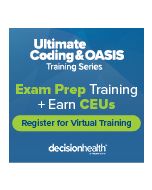 Ultimate Coding & OASIS Training Virtual Series: ICD-10 Intermediate Coding
Ultimate Coding & OASIS Training Virtual Series: ICD-10 Intermediate CodingFrom $549.00
To $1,947.00
-
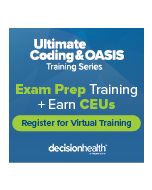 Ultimate Coding & OASIS Training Virtual Series: ICD-10 Coding Basics
Ultimate Coding & OASIS Training Virtual Series: ICD-10 Coding BasicsFrom $425.00
To $1,823.00
-
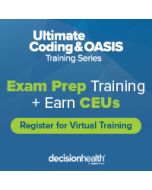 Ultimate Coding & OASIS Training Virtual Series: OASIS Training
Ultimate Coding & OASIS Training Virtual Series: OASIS TrainingFrom $525.00
To $1,923.00
